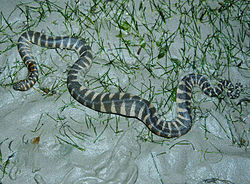| Acrochordus | |
|---|---|
 | |
| Acrochordus arafurae | |
| Scientific classification | |
| Kingdom: | Animalia |
| Phylum: | Chordata |
| Class: | Reptilia |
| Order: | Squamata |
| Suborder: | Serpentes |
| Superfamily: | Acrochordoidea |
| Family: | Acrochordidae Bonaparte, 1831 |
| Genus: | Acrochordus Hornstedt, 1787 |
The Acrochordidae, commonly known as wart snakes, [2] Java wart snakes, [3] file snakes, elephant trunk snakes, or dogface snakes are a monogeneric family [2] created for the genus Acrochordus. This is a group of basal aquatic snakes found in Australia and tropical Asia. Currently, three species are recognized. [3]



